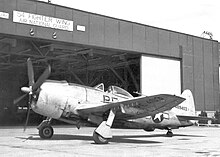Republic P-47 Thunderbolt variants
In response to a USAAC requirement for a new fighter aircraft, Republic Aviation engineer Alexander Kartveli proposed the AP-10 lightweight high-altitude interceptor on August 1, 1939.[1] As originally proposed, the AP-10 was to have been powered by a 1,150 hp Allison V-1710-39 12-cylinder inline engine and have an armament consisting of two nose-mounted .50 in (12.7 mm) M2 Browning machine guns.Kartveli revised the AP-10 by slightly increasing its size and mounting two .30 in (7.62 mm) M1919 Browning machine guns in each wing, raising the gross weight to 6,570 lb.[2] Expecting the USAAC to reject the XP-47 for the more suitable Curtiss XP-46, Republic canceled the XP-47 and XP-47A and Kartveli began an extensive redesign of the aircraft.[2] Armament was increased to eight M2 Brownings, four mounted in each wing, making it one of the heaviest-armed fighters considered by the USAAC at the time.It was powered by a 1,960 hp XR-2800-21 engine and featured an elliptical wing, an all-metal construction (except for the fabric-covered control surfaces), and a hinged canopy.The resulting P-47C featured a redesigned metal rudder, as the original fabric-covered unit was prone to tail flutter which frequently led to crashes.The initial production block was based on the P-47C-2-RE[4] or C-5-RE,[8] but with two additional cowl flaps (for a total of five) on each side (this was absent on early aircraft, making them indistinguishable from P-47Cs).In an attempt to improve the performance of the Thunderbolt, Republic began a project to install a 2,300 hp Chrysler XIV-2220-1 16-cylinder inverted-V engine in two P-47D-15-RE airframes in August 1943.A production version of the XP-47J was canceled in favor of another Thunderbolt development, the XP-72, as were plans for installing an R-2800-61 engine with contra-rotating propellers.[18] Deliveries began in December 1944, though engine problems delayed their combat debut until a few weeks before the end of the war in Europe.[20] The aircraft was a development of the bubbletop P-47D, but was to be powered by 3,450 hp Pratt & Whitney R-4360-13 Wasp Major 28-cylinder radial engine driving contra-rotating six-bladed Aeroproducts propellers and armed with six M2 Brownings.












P-47 ThunderboltWorld War IIfighter aircraftRepublic AviationRepublic P-47 ThunderboltAlexander KartveliinterceptorAllison V-1710-3912-cylinderinline engine.50 in (12.7 mm)M2 Browning machine guns.30 in (7.62 mm)M1919 Browning machine gunswar in EuropeLuftwaffeself-sealing fuel tanksCurtiss XP-46turbo-superchargedPratt & Whitney R-2800 Double Waspradial engineelliptical wingaileronselevatorsphoto-reconnaissanceintercoolerlaminar-flowSCR-274-NFarmingdale, New Yorkcenter of gravitydrop tankwhip antenna365th Fighter GroupEvansville, Indianacowl flapswater injectionHamilton StandardCurtiss ElectricDuxford Air ShowCurtiss-WrightBuffalo, New YorkChrysler XIV-2220-116-cylinderJet Agecontra-rotating propellersbubble canopyHawker Typhoonstarterradio direction finderdive brakestail warning radarV-1 flying bombjet fightersMesserschmitt Me 262rocket fightersMesserschmitt Me 163 Kometend of the war in Europewar in the Pacificwet wingVJ DayUnited States Air ForceRepublic XP-72Republic XP-69Pratt & Whitney R-4360-13 Wasp MajorPeter M. BowersWilliam GreenRoger A. FreemanRepublicXF-84HXF-103AP-100RF-84FLancerRainbowRocketSeabeeSnooperSwallowThunderbugThunderboltThunderceptorThunderchiefThunderflashThunderjetThunderscreechThunderstreakTri-ServiceCurtiss P-4Boeing P-4RF-61CF-84F/JF-86D/G/K/LF-100BF-102BXF-104F-104SNF-104AXF-106F-111BF-111CF-111KAFTI/F-111AEF-111AF-1C/DF-1E/FF-4K/MF-9F–JF-15EXF-15 STOL/MTDF-16XLNF-16DF/A-18F/A-18E/FEA-18GYF-110YF-110B/DYF-110CYF-113 (I)YF-113AYF-113B/DYF-113 (III)YF-113CYF-114YF-114C/DYF-117AYF-117D